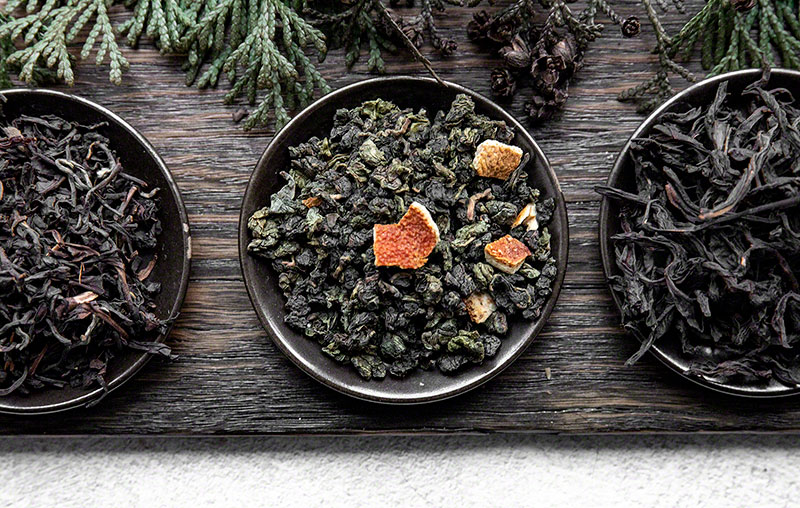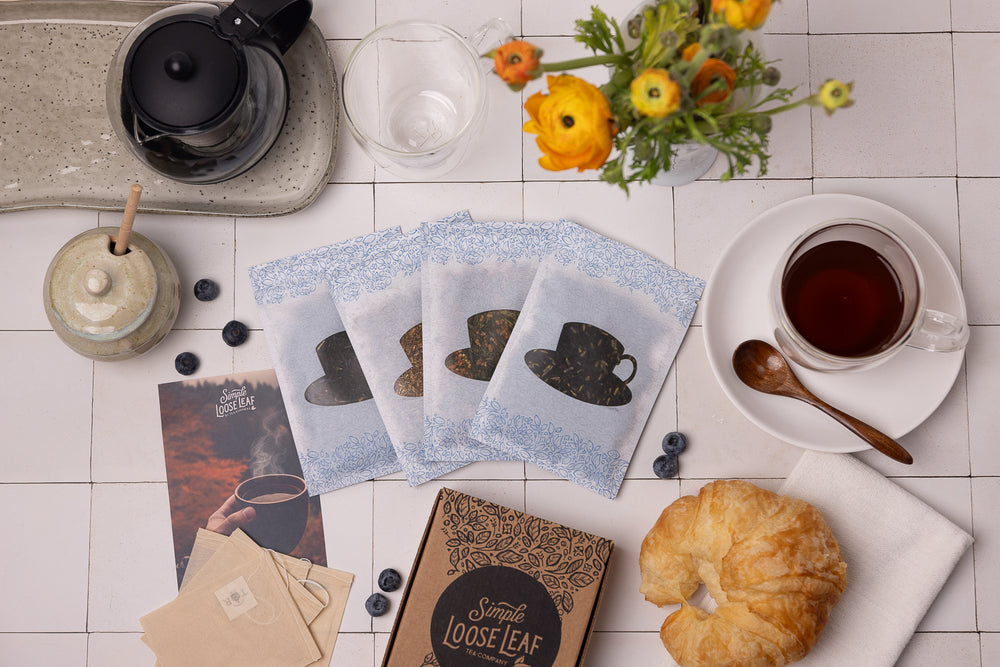What does Oolong Tea taste like?
Oolong or black dragon is the only tea type that doesn’t have a color in its name. Could that be a coincidence? What does oolong tea taste like? Learn about different flavors, colors and shapes of oolong tea and how to choose the one you will like.
What is oolong tea?
Oolong tea is one of the main six tea types. Oolong is grown mostly in Mainland China and Taiwan, and it’s popular in Vietnam, Thailand, Indonesia and Japan too. Fujian and Guangdong provinces of China are the top producers of oolong tea. Oolong is semi-oxidized, usually between 20% and 80%, but some types may be even less or more oxidized. Think of an oolong tea as a type between unoxidized green and fully oxidized black tea. The lower the number, the closer the flavor will be to green tea and same is true for the color. Oolong tea can have a very bright green or yellow, or very dark amber and red color. Oolong tea undergoes different processing methods, making the taste very different from both green and black teas. The first step in processing oolong tea is withering. Tea leaves are withered after harvesting, a step common in producing Chinese tea. The next steps include bruising, stopping oxidization process, rolling and roasting.What influences the flavor of oolong tea?
The flavor of oolong tea will depend on:- Tea cultivar
- Terroir
- Production processes including oxidation and roasting
- Aging
What are the most important types of oolong tea?
Oolong tea comes in two main shapes – ball shaped or with long twisted leaves. For example, all Taiwanese high mountain oolong teas are ball shaped, including a bud and more leaves with whole branches. On the other hand, Chinese Ti Kwan Yin is also ball shaped, but should never include whole branches. Chinese Dan Cong teas have twisted long and elegant leaves, while the Wu Yi rock oolong will usually have twisted, but plumper and shorter leaves. Some of the most important types of oolong tea are:- Chinese Wu Yi rock tea with distinctive mineral note and fruity flavor, usually heavy oxidized
- Chinese Dan Cong teas each and every with a distinctive flavor resembling magnolia, almond,
- Taiwanese bug bitten oolongs like Oriental Beauty and Honey oolongs with refined and sometimes very strong natural honey and ripe fruit flavor
- Chinese Anxi oolongs with flavors ranging from lightly floral and nutty to stronger, almost full bodied flavor with even acidic and roasted notes
- Taiwanese high mountain green oolong tea with light floral notes, fruity notes and milky textures
- Taiwanese Dong Ding oolongs, ranging from lightly roasted to heavily roasted with rich and fruity flavor

Oriental Beauty, Ti Kwan Yin with orange peel and Wu Yi Qi Lan oolong
There are many other types of oolongs in the world, such as black oolong tea that is very heavily oxidized (90 or more percent) and resembles stronger, but fruity black tea, such as unsmoked Lapsang Souchong. Japanese oolong teas are often more oxidized, with a beautiful orange to red color and taste combining characteristics of fruity black tea and hojicha.Is oolong tea scented?
Most oolong teas are not scented or flavored, but some can be used as an amazing base for adding flowers or dried fruits. The most common flowers for scenting are rose, osmanthus and jasmine. Citrus flavors match the character of lightly oxidized oolongs almost perfectly, while the stronger fruit and chocolate notes go well with more oxidized types. Good examples are Orange Blossom oolong with light oolong as a base and orange peel, and Crème Brulée with dark oolong tea, almonds, cinnamon and jasmine flowers. Some oolong teas are never scented, flavored or blended, for example, a Dan Cong tea.Best tasting oolong tea
The best tasting oolong tea will have no bitterness, will offer multiple infusions and will have recognizable notes of both cultivar and terroir. To understand the Chinese rock tea, we recommend trying two of the most popular rock teas – Red Robe or Da Hong Pao and Qi Lan. If you want to get to know the world of Dan Cong tea, try with Phoenix Dan Cong, a truly unique tea with scent and aroma that will overwhelm a first-time drinker. This type of tea offers the most infusions, even up to 15, has a very strong flavor, but requires a lot of patience and attention for brewing. Chinese Ti Kwan Yin or the Iron Goddess of Mercy is a classical among oolong teas. It can be brewed in a mug, in the western style or using multiple steep technique, offering different notes depending on temperature and steeping time. If you love honey, Taiwanese honey oolong may be the best tasting oolong tea you have ever tried. The best tasting dessert tea with a bit subtler honey note is a White Tipped Oolong (Oriental Beauty). Find out what are the top 4 oolong teas for beginners.Does oolong tea taste like black tea?
If heavy oxidized, oolong tea can taste like black tea, but it will rarely be full bodied. Some oolong teas can be oxidized up to even 99%, however, that is quite rare. Black oolong tea will very likely resemble the notes of slightly fruity Chinese black teas. Even heavily oxidized oolongs are usually more playful and aromatic than regular black tea.Is oolong tea healthy?
Other than exquisite flavors, oolong tea has some scientifically proven health benefits. What makes it unique is having both green and black tea compounds. Therefore, oolong tea will contain EGCG too. The most important potential benefits may include aiding weight loss, improving gut health, reducing inflammation, reducing cholesterol and reducing the risk of heart diseases. Side effects are very unlikely, but keep in mind that oolong tea contains caffeine. Some types may contain more than black tea. Learn more about the 15 unique benefits of oolong tea here.How to brew the best cup of oolong tea?
When brewing high quality oolong tea, patience, good water and proper utensils are all important. First, learn more about the type you want to brew. Some oolongs are better steeped for only a few seconds, while other may give a wonderful cup when you infuse the leaves for more than 5 minutes. Most oolongs are suitable for both short steep technique and long steeping. Fresh spring water is especially important for making a best tasting cup of tea. For example, higher mineral content in some spring waters may bring more mineral notes in Wu Yi rock teas. To get the most flavor out of oolong tea, use a smaller teapot and 1 gram of tea leaves per 20-30 ml of water. The temperature should be from 185 to 203 °F. Wash the leaves first by steeping them for only a few seconds and discarding the brew. Then steep for 10- 20 seconds and increase the time with each subsequent brew until the flavor is completely gone. To brew oolong tea western-style, use about one teaspoon of leaves per cup and brew for 1-3 minutes. Water temperature should be around 185 °F.Tip: Rolled oolong teas are some of the most beautiful loose leaf teas to watch when brewing. Try using a glass teapot to maximize the brewing experience.For making iced tea, brew the tea in the western style, but use double the amount of the oolong tea leaves. Steep for 5-10 minutes. Cool in the fridge or top up with ice and add a sweetener.
Notes:
Disclaimer: The purpose of this article is not to diagnose or treat any diseases, or to replace an opinion of a professional doctor. Never self-treat any diseases, or drink large quantities of tea, real or herbal, if you are suffering from serious diseases, are pregnant or breastfeeding. As every person is different, it’s impossible to make a general statement about the benefits or side-effects.
More from:
SLL




Leave a comment